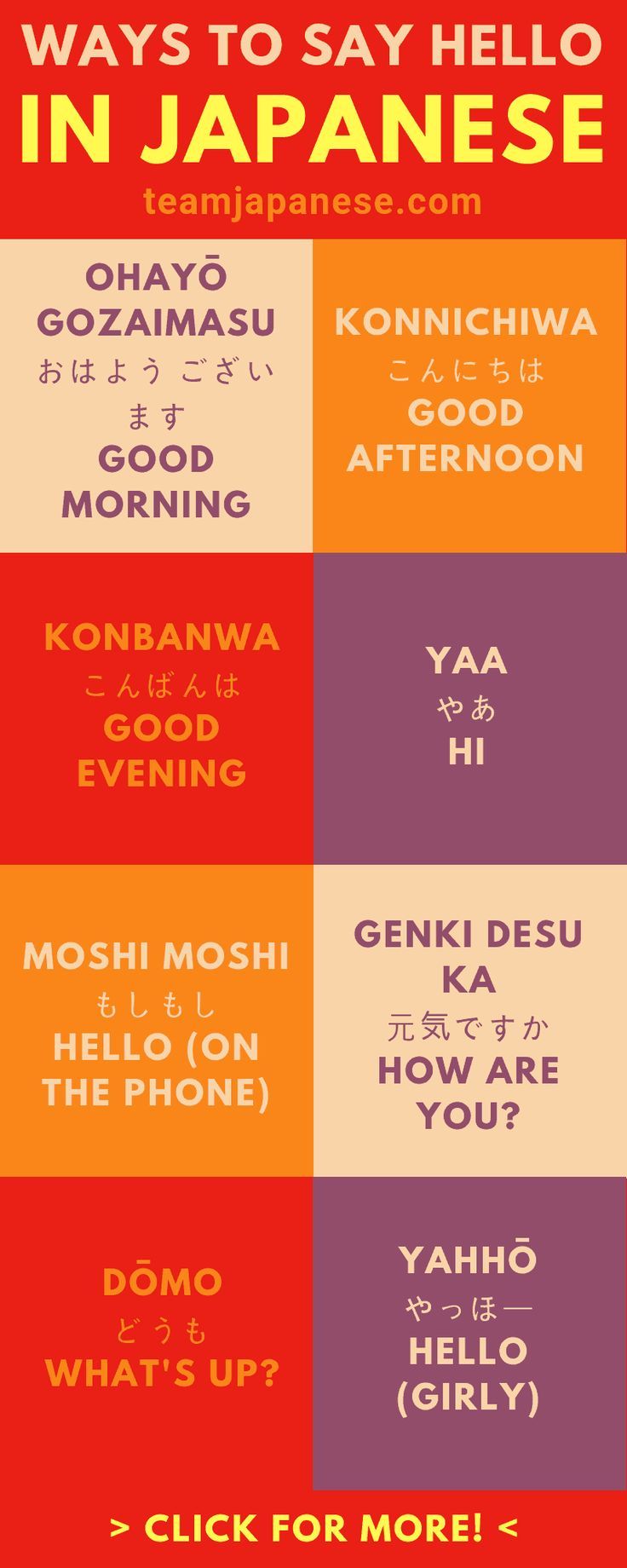
How to say "How are you?" in Japanese YouTube
Here are some examples. あんた Anta: In Kinki (Western Japan), it is a friendly and endearing word but in Kanto (Eastern Japan), it is considered rude and insulting. わい Wai: Depending on the region, it can mean either 'I' or 'You'. 自分 (ジブン) Jibun: Kansai dialect that means 'You' depending on the context.

Simple phrases Basic Japanese Words, Japanese Phrases, Study Japanese
1) Say their name Simply using the person's name is the best way to say you in Japanese. In fact, that's what you would use instead of "anata," which is mentioned below. You should add honorifics like chan or kun to make it sound more friendly.
:max_bytes(150000):strip_icc()/how-to-say-hello-in-japanese-1458398_FINAL-5c623513c9e77c0001d322a3.png)
Say Hello in Japanese (Basic Greetings, How to Bow)
1. あなた — Anata 2. 君 (きみ) — Kimi 3. あんた — Anta 4. お前 (おまえ) — Omae 5. てめえ — Temee Bonus: Talking to Groups and Saying "Your" More Natural Ways to Say "You" (Without Actually Saying "You") 1. [Name] + title 2. No pronoun at all And One More Thing. Download: This blog post is available as a convenient and portable PDF that you can take anywhere.

How to say how are you in Japanese YouTube
1. お元気ですか? Asking about their "genki-ness" - How are you? This is #1 most common way to way to ask how someone is in Japanese. You'll read this in every textbook and hear this in every lesson. Genki simply means "lively" or "healthy."Here's the polite version to use for strangers and older people. O Genki desu ka? お元気ですか?

Essential Japanese Phrases for Travel Wanderlust Chronicles Travel
The easy and polite way is to say: は日本語で何と言いますか? はにほんごでなんといいますか? Just replace the with whatever English word or phrase you want to know and you are all set! There are other ways to ask how to translate your phrases from English to Japanese. Inevitably when you learn Japanese you will be asking how to do so often.

How to say "How do you say this in Japanese?" YouTube
In the morning, you can use おはようございます ( Ohayou gozaimasu ), and in the evening, こんばんは ( konbanwa ). Konnichiwa actually means "This day is…" but it's used now to say hello. 2. "Please" in Japanese - ください ( Kudasai) There are a couple of ways to say "please" in Japanese. The most universal.

Learn Japanese Master Basic Greetings In Japanese Fast Japanese Photos
と (to) is the most common and direct way to say and in Japanese. It can be used to connect two nouns in a sentence, but not for phrases or even clauses. It joins two nouns together in a closed list - there is nothing else. In fact, と (to) is the only conjunction that equals the English conjunction and. Structure: Noun 1 + と + Noun 2.

Instagram post by Valiant Language School 🇯🇵 • Mar 18, 2017 at 211am
234K views 2 years ago Japanese Conversational Phrases https://bit.ly/2XmBPjh ← if you want to learn more vocabulary, phrases, and example sentences you can use in real-life situations, click.

Easy Japanese Words For Kids
The Basic Translation of "It's OK" in Japanese. The most straightforward translation of "It's OK" in Japanese is 「大丈夫です」 (daijoubu desu). This phrase can be used in various situations such as when someone offers you something, asks if you're feeling well, or apologizes for something minor. It's a polite way to say.

How to Say How Are You in Japanese in 3 Ways for Formal and Informal
11 I have always wondered how to ask someone (like my Japanese teacher) to tell me how to say something in Japanese. For example, I wanted to ask Kato Sensei how to say "Please send me a photo via Instagram DM." If I were to ask her in English, I would say, "How do you say 'Please send me a photo via Instagram DM' in Japanese?"

How To Say Alright In Japanese How to say alright in japanese
」 are some common ways you could say this. However, you can also return the question; as in English, this especially depends on how long the first answer is. As an example, in: A:「兄弟はいますか?」 B:「残念ながら一人っ子です。Aさんのほうは?」 reiterating the question could come off as a bit awkward (but.

Pin en Learn japanese
More Formal or Polite Ways to Say Hello in Japanese. 8. はじめまして (Hajimemashite) - Nice to meet you. Used when you meet someone for the first time. If a third person is introducing you to another person, you can just say "Hajimemashite." However, if you have to introduce yourself, then you'd say: はじめまして。 です。

How do you say "hello" in Japanese? How to say "hello" in Japanese
5.1 Good. 5.2 So-So. 5.3 Not Good. 5.4 Thank You for Your Concern. 6 Other Basic Greetings in the Japanese Language. 6.1 Standard Form. 6.2 Informal and Abbreviated Form. 6.3 Casual and Easy-Going Form. 7 "How Are You" in Japanese and The Gifting Customs.

how to say hello in japanese with the words on each side and an image
Learn more: Japanese Greetings: 17 Ways to Say "Hello" in Japanese Japanese Pronouns: I: 私 ( watashi) You: あなた ( anata) This: これ ( kore) That: それ ( sore) He: 彼 ( kare) She: 彼女 ( kanojo) They: 彼ら ( karera) Learn more: Japanese Honorifics: How to Show Respect in Japanese Japanese Numbers: One: いち ( ichi) Two: に ( ni) Three: さん ( san)

23 Japanese Slang Words You Should Know
When a teacher talks to a student : [student family name] + さん san. In some cases, [family name of a male student] + 君 くん kun. The following are frequently used Japanese classroom phrases by teachers in a class. 1. Instructions. [Japanese] みんな、席に着いて。. Minna, seki ni tsuite. [English] "Everyone, be seated.".

How to Say Japan in Japanese 5 Steps (with Pictures) wikiHow
Google's service, offered free of charge, instantly translates words, phrases, and web pages between English and over 100 other languages.